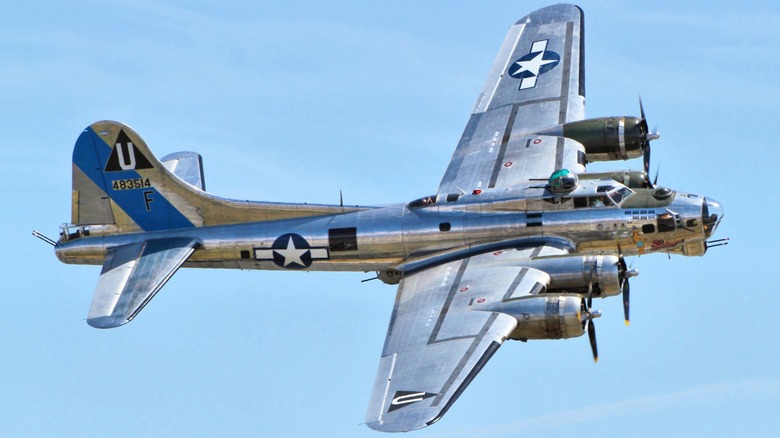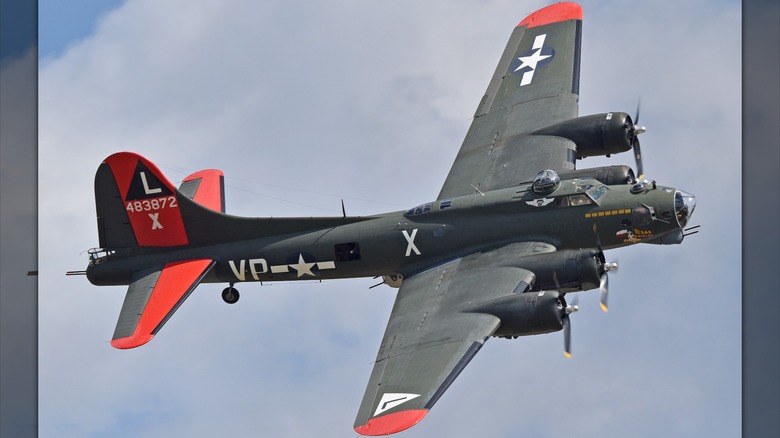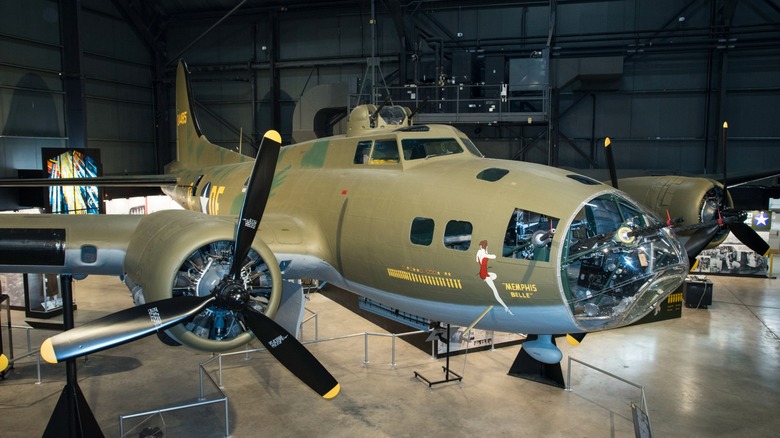How Many B-17 Bombers Are Still Flying Today?
Of all the heavy bombers flown during World War II, the Boeing-built B-17 Flying Fortress is one of the most well-known and beloved. It spent most of the conflict fighting against the Germans in the European Theater, and Boeing made a ton of them. The company's Seattle, Washington, plant produced 6,981, while Lockheed, under license, produced 2,750 at its plant. Another 2,995, also made under a license, were produced by Douglas, so a total of 12,726 B-17s were built during World War II.
It's fair to say that the B-17 helped the Allies win WWII, though many were destroyed along the way. Of the 12,726 produced, a total of 4,735 were lost during combat operations, accounting for just over 37% of the total force. When the war ended, most B-17s were retired from military service. Some were put into civilian use for firefighting purposes. Unfortunately, after more than 80 years, the vast majority of the surviving 7,992 B-17s are either destroyed, scrapped, or utterly incapable of ever taking flight again.
Fortunately, a handful have survived into the 21st century, though the numbers are far diminished from the wartime inventory. Fewer than 55 aircraft remain, and of those, only eight are known to be flightworthy. Most of these fly in air shows, such as the "Sentimental Journey," based out of the Commemorative Air Force Museum in Mesa, Arizona. It regularly flies at national air shows, showing off its Betty Grable nose art and beautifully sleek silver coat.
There aren't many B-17s remaining
Like any vintage military aircraft, there are collectors who value them as Warbirds, but there are so few B-17s remaining that they're incredibly hard to come by. Because each plane had a unique serial number, some dedicated enthusiasts have accounted for as many as possible, and there are several sites devoted to keeping track of the remaining B-17s. While some of these have conflicting numbers, they all agree on one thing: there aren't many that can still fly. Aerovintage lists only three, though its more exhaustive figures elevate that number to eight.
The breakdown consists of one aircraft in long-term maintenance, which will likely fly again one day. There are 24 known to be on static display in museums, and another six are under restoration to make them operational. Two are being worked on to restore them so they can be displayed in museums, while six are known to be in storage. There are six partial airframes and 47 complete airframes for a total of only 53 surviving B-17s in existence.
Additionally, there are two projects underway to construct B-17s from mostly new, as well as some original components. Unfortunately, there have also been losses of aircraft that were restored and made airworthy. For example, in November 2022, the B-17G "Texas Raiders" flew in an air show at Dallas Executive Airport, Texas and collided with a P-63 Kingcobra that not only destroyed both aircraft, but it also cost the lives of all five B-17 occupants and the pilot of the P-63.
Some notable B-17s you can visit in museums
Restoring a vintage B-17 isn't easy or inexpensive. Thankfully, several museums have done the work so these amazing aircraft can be appreciated for generations to come. There are at least two dozen spread about, and a few of these are particularly noteworthy for their wartime service records. The most famous B-17 is undoubtedly the B-17F "Memphis Belle," which is also the name of a 1990 feature film. It depicts its crew preparing for "Memphis Belle's" 25th and final bombing run over Germany in 1943.
The Memphis Belle has been fully restored to absolutely brilliant, though not airworthy, condition in the WWII gallery at the National Museum of the United States Air Force in Riverside, Ohio. Another important aircraft that's housed in the same gallery is "The Swoose," a B-17D and the only known "shark fin" model that still exists. It fought during the opening days of the conflict in the Pacific, which was somewhat unusual for the B-17, which almost entirely flew in the European Theater.
It was originally known as "Old Betsy," but was renamed in 1942. The B-17G "Shoo Shoo Shoo Baby," also housed at the National Museum of the United States Air Force. It served with the 91st Bomb Group, "The Ragged Irregulars," and flew 24 combat missions in Europe. It was found in France in 1968 and returned to the U.S. by the French government a decade later. After a ten-year restoration process, it was returned to flying condition.


